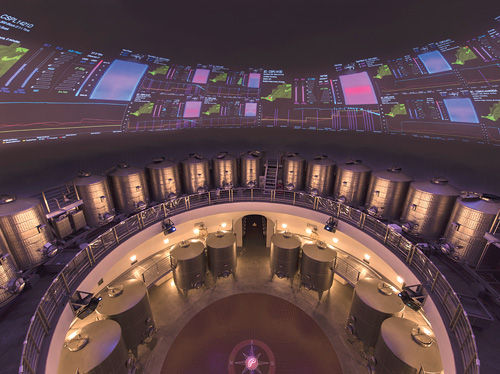Smartphone users reprogram winemaking
TankNet might not be a household name, but for winemakers like Rodney Strong, between Healdsburg and Windsor, it is the brainstem of a technological revolution in the wine industry.
From controlling the fermentation process in the tank room, to generating a 3-D image of what is going on inside the tank, TankNet has become the go-to tech for the geeks of wine and beer making.
The instant control extends beyond dials on a console, or a laptop computer wired into the tank room. Winemakers from Asti Winery in Cloverdale to Korbel in West County are able to monitor, make adjustments and tinker with their wine with a smartphone app.
TankNet started out as a computer based process to monitor and control the fermentation process in winemaking, giving vintners an advantage in foreseeing and avoiding problems before they happen.
To Paul Egidio, Chief Technical Officer for Acrolon Technologies, Inc., going from a traditional desktop or laptop computer to a tablet and smartphone was “just a natural iteration of the progression” of TankNet.
At Rodney Strong Vineyards, winemaker Justin Seidenfeld uses TankNet to monitor and control 57 fermentation tanks inside a single warehouse after an $8 million upgrade to the facility.
“We are a sustainable winery. The definition of sustainability is for us to be here in 50 years,” said Seidenfeld. The tank room is packed with square tanks, a deviation from the traditional cylindrical tanks used by most wineries. The combination of the carefully designed fermentation tanks and the TankNet control system has boosted Rodney Strong’s production to 240 tons of wine per vintage, a 24 percent increase.
Seidenfeld now uses the TankNet app on his smartphone to make adjustments in temperatures in each individual tank in real time.
By setting his own alarm specifications, he is alerted to problems in the winemaking fermentation process. In many ways the app is like those that people use to monitor their homes from far away, even locking doors and turning off the stove from a vacation spot on the other side of the globe.
In addition to being able to adjust the temperatures in the tanks, Seidenfeld is able to perform what are called “pump overs” and “punch downs.”
With a swipe on the screen, a winemaker is able to pump the fermenting grape juice from the bottom of a tank to the top, quickly evening out the temperature of the liquid throughout the tank.
With the same level of control, the grape skins and pulp can be pushed down into the vat to maintain the desired levels of color, texture and flavor needed to create a good wine.
While Rodney Strong utilizes the TankNet system to maximize the amount of quality wine it produces, a Napa Valley winery has taken quality control to a science fiction level.
If Batman had a winery, that winery would be the wine cave at Palmaz Vineyards, 18 stories underground in the neighboring Napa Valley. “I’ve heard that before,” said wine geek Christian Gastón Palmaz, who has spent millions of dollars and about five years designing and building a high tech fermentation room.
While Palmaz still has the convenience of making adjustments to his fermentation tanks through his smartphone, his TankNet system allows an overhead view of what is happening inside his fermentation tanks.
According to Seidenfeld, TankNet is designed to be integrated with a variety of types of equipment and software in the winemaking business. Palmaz incorporated TankNet with his own program, called FILC (Fermentation Intelligent Logic Controler, pronounced “Felix”) to create a planetarium style monitor.
Overhead, in the Palmaz wine cave, a dome acts as the canvas for eight, high powered projectors beaming data rich images.
The reason for the elaborate system of graphs, numbers and 3-D images is to give winemakers more freedom. “Winemakers don’t want to carry around a tablet, they want to carry a glass,” said Palmaz.
From below the brightly lit domed ceiling of the Palmaz wine fermentation chamber, vintners can see what is happening inside the fermentation tanks by watching the numbers, graphs and even a data-driven image that shows everything happening inside.
“Let’s say I put a person inside the tank, you would see the outlines of the person. The system works by literally imaging what’s inside the tank,” said Palmaz.
While the complicated system that monitors three to four million points of temperature 10 times per second might seem to take some of the magic out of winemaking, Palmaz sees it as a way to focus on the ultimate question of fermentation: “How far along am I?”
TankNet, and Palmaz’s FILC system generates a precise method of determining how much sugar remains in the tank that will eventually be converted to alcohol. The proper term is “brix.”
“The issue is, the winemaker, this very talented person, is spending half of their time going up to the tank and pulling these numbers to try and determine where they are in the fermentation when really what they should be doing is tasting and thinking about the wine, artistically,” said Palmaz.
2014 is the first vintage for Palmaz’ high tech wine cave, although the vineyards date back to the 19th century and the first bottles for the new winery were produced in the 1990s.
According to Egidio, TankNet started in Napa County in the late 1990s as a spreadsheet program with clickable links to monitor individual tanks.
From those humble beginnings, TankNet is now found in hundreds of wineries and breweries on nearly every continent, and dozens in Sonoma County, and has, since its inception, connected vintners to their fermentation rooms via the Internet.
47.6
F
Healdsburg
April 21, 2025








